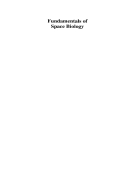




Mã tài liệu: 202334
Số trang: 391
Định dạng: pdf
Dung lượng file:
Chuyên mục: Khoa học công nghệ
Fundamentals of Space Biology is the third textbook addressing Space Life Sciences in this Space Technology Library series. The first of these books focused on the psychological and psychiatric issues that affect people who live and work in space (Volume 16, Space Psychology and Psychiatry). The second book described the physiological and medical issues of living in a space environment (Volume 17, Fundamentals of Space Medicine). The objective of this third book was to review the effects of spaceflight on less complex biological systems, from single cells to animals and plants. Indeed, to better understand the changes at the function level, it is necessary to comprehend the changes at cellular and tissue levels. Studies of cell cultures, for example, allow the investigation of the indirect effects of gravity; i.e., those which occur not because of changes in the stimulation of dedicated gravity-sensing organs, but because of the new physical properties resulting from the reduction in gravitational force within the cell. Furthermore, studies of animals and plants in space allow investigations of the effects of gravity on development, a research field that is not open to human subjects. The International Space Station era promises opportunities to observe and test various features of animal and plant development during long-term exposure to microgravity, with access to centrifuges capable of exposing the specimens to fractional g-loads. Recent
space missions, such as Neurolab, have provided evidence for the existence of critical periods when gravity is necessary for the normal development of frogs and rats. The ability to raise animals and plants on the International Space Station over several life cycles should allow scientists to establish precisely the how, when, where, and why of this gravity dependence.
There is no doubt that the Earth's gravitational field influences the morphology, physiology, and behavior of life in virtually all its manifestations. The common motivating force for the space biologists is a genuine desire to understand the role that gravity has played in the evolution of life on our planet, whether a single-celled microorganism, or a complex multi-cellular organism, such as a plant or an animal. Space biology research encompasses a broad range of biological sub disciplines, including gravitational, developmental, and radiation biology. It also focuses on advanced technologies that include research in genomics, molecular and nano-technologies, DNA arrays, gene-array technologies, and cell culture and related habitat systems; thus, reflecting the evolving nature of biological research as well as the ever-increasing linkage between science and technology.
Những tài liệu gần giống với tài liệu bạn đang xem
Những tài liệu bạn đã xem
 Fundamentals of Space Biology
Fundamentals of Space Biology is the third textbook addressing Space Life Sciences in this Space Technology Library series. The first of these books focused on the psychological and psychiatric issues that affect people who live and work in space
pdf Đăng bởi
haiquocluu_kd
Fundamentals of Space Biology
Fundamentals of Space Biology is the third textbook addressing Space Life Sciences in this Space Technology Library series. The first of these books focused on the psychological and psychiatric issues that affect people who live and work in space
pdf Đăng bởi
haiquocluu_kd